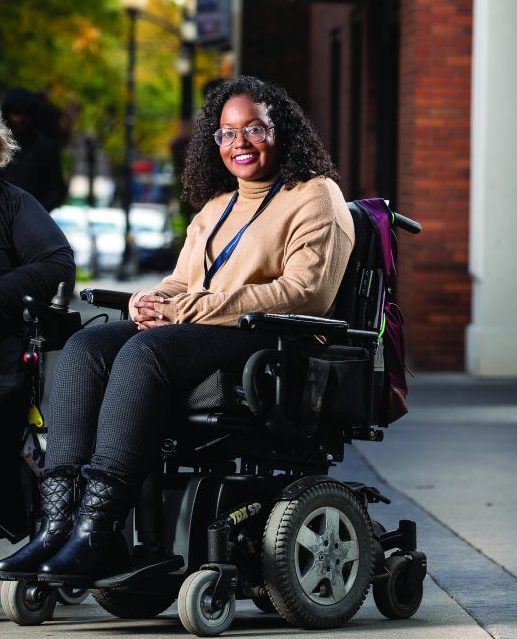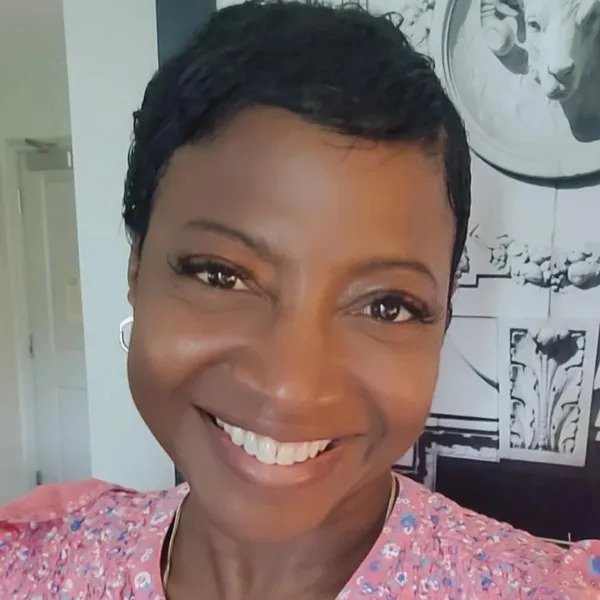Accessibility

What is accessibility?
Accessibility is the extent to which information, environments, products and systems are usable for everyone. Accessibility should be incorporated into everything from web design, architecture, policies and procedures, and education plans to address common barriers that exist all around us.
Barriers to accessibility
Much of what "disables" people is not the disability itself, but rather an inaccessible environment created without the inclusion of persons with disabilities in mind. A barrier is anything that keeps someone from fully participating in society. Barriers exist in all aspects of the environment – in physical and virtual environments, policies and procedures, and ableist attitudes.
Common types of barriers include attitudinal, architectural or structural, information or communication, technology, and systemic barriers.
When thinking about accessibility, it is essential to be aware of both visible and invisible barriers. For example, physical or structural barriers such as stairs or doorways are common visible barriers. However, sometimes a process or policy can unintentionally create barriers in an organization. Information in a format that may not be accessible to everyone can also create a barrier.
Attitudinal barriers are often the most challenging and stem from the way people think or behave. They can be based on stereotypes or simply a lack of understanding of another person’s lived experience. They often result in ableism – defined as discrimination and social prejudice against persons with disabilities. Ableism characterizes and defines persons by their disabilities and as inferior to non-disabled people. However, it is within our power to change our attitudes and behaviours.
Attitudinal barriers: Refers to perceptions, assumptions and behaviours toward persons with disabilities, resulting in negative interactions. Attitudinal barriers are best addressed through awareness and training initiatives.
Organizational/systemic barriers: This includes policies, procedures, programs and practices, which do not fully take into account the needs of persons with disabilities. In a post-secondary environment, these barriers can include teaching and learning practices, admissions and accommodations processes. Barriers may also exist at events and programming, and are further exacerbated by university fees and inadequate funding which may pose barriers for students with disabilities unable to access services due to financial constraints.
Architectural barriers: This includes physical elements in the built environment such as narrow pathways, absence of elevators and ramps and lack of accessible washroom facilities. It also entails lack of maintenance efforts for general upkeep of accessible features.
Information & communication barriers: Refers to visual and verbal communication barriers such as poor formatting, small font sizes, videos without captions and lack of access to sign language.
Technological barriers: Exist in conjunction with information and communication barriers, in virtual environments. For example, online content that cannot be accessed with assistive technology such as screen readers.
What is ableism?
Ableism is “a system of negative attitudes, stereotypes and stigma towards persons with disabilities that devalue and limit them from fully participating in society and their potential as persons with disabilities (Ontario Human Rights Commission).”
Ableist attitudes
According to the OHRC, ableist attitudes may be “conscious or unconscious, and may be embedded in institutions, systems, or the broader culture of a society. It can limit the opportunities of persons with disabilities and reduce their inclusion in the life of their communities.”
Types of ableist attitudes
- The medical model of disability is when disabilities are regarded as a deficit of the individual or an “issue” that must be fixed.
- Example: Asking persons with disabilities what’s ‘wrong’ with them and what they can’t do.
- The tragic or inspirational attitude is when persons with disabilities are viewed as objects of pity or inspiration.
- Example: Calling persons with disabilities ‘inspirational’ for the sole reason that they have disabilities.
- “The only disability in life is a bad attitude.”
- The overcoming attitude occurs when persons with disabilities are seen as lacking resilience or, in contrast, are applauded for their resilience.
- Example: “They are disabled because they didn’t try hard enough” or “If they made more of an effort, they could fix their disability.”
For more information and resources on challenging ableism, visit the Access TMU website.

Promoting accessibility and inclusion
Accessibility is essential to respecting the dignity of persons with disabilities, and to allow for their full participation in all aspects of personal, academic and public life. To be truly effective, organizations need to have an ongoing critical examination of policies, programs, practices and services to identify and remove barriers to accessibility. Disability is not a monolith and individuals with similar visible and/or invisible disabilities may experience things differently or have different needs, especially when considering intersectional identities.
Below are some tips to build more disability inclusive personal and professional practices:
- Ensure that persons with disabilities are included in the design, implementation and evaluation of a project. When persons with disabilities are consulted throughout the process, it becomes easier to proactively identify and address potential barriers and create more accessible projects, lesson plans, products and environments that are considerate of differing needs.
- Consider accessibility across communications. Employing accessible communication strategies enables persons with visual, hearing and learning disabilities to meaningfully engage. Accessible communication strategies can include:
- captioning and/or sign language interpretation in videos and presentations
- alt text for images and photographs
- larger text and font size in printed and presentation materials
- using an accessibility checker to ensure accessible text and colour contrast
- descriptive hyperlinks that clearly identify the content of the linked resource
- headings to present data instead of tables which are not compatible with most screen readers
- communications that meet different learning, information processing and retention styles
- Ensure that meeting, classroom and event locations meet accessibility needs. Consider varying needs in the design of in-person and online engagements to remove barriers to participation and create equitable opportunities for full participation. Accessibility considerations for in-person engagements may include:
- selecting meeting spaces that are wheelchair accessible, have automatic door openers, and proximity to wheelchair accessible washroom
- Include accessibility details in program information page and ensure there is an option in the registration process for accommodation requests to be made
- ensuring social and congregate spaces are spacious enough to allow for mobility devices and other assistive supports such as guide dogs
For more information about designing inclusive experiences, refer to the guides and resources offered by Access TMU.
Communication
Keep the following in mind when communicating with persons with disabilities:
- Be respectful.
- “Speak in an age-appropriate tone and treat adults as adults.” (external link)
- Avoid stereotypes and assumptions about a person’s disability or capabilities.
- Be patient – sometimes communicating with someone with a disability may take a bit longer.
- It is always best to ask the person with a disability prior to offering assistance.
- Ask the person with a disability what form of communication works best for them. For example, even if you have written notes, it may help to verbalize the information.
- Never pretend to understand someone with a speech impairment if you don’t. Instead, repeat what you’ve understood and allow the person to clarify if needed.
Inclusive language guidelines
Inclusive language is free from terminology, tones or phrases that reflect stereotyped or discriminatory views of particular people or groups. Explore the following inclusive language guidelines:
- (PDF file) Inclusive Language in Media: A Canadian Style Guide (external link) (Source: Humber College)
- Includes guidance and terminology when speaking about persons with disabilities.
- (PDF file) Words Matter: Guidelines on using inclusive language in the workplace (external link) (Source: British Columbia Public Service)
- Includes guidance on writing about culture, ancestry, religion, marital/family status, age, sexual orientation, gender identity, and more.
- A Way with Words and Images: Suggestions for the portrayal of people with disabilities (external link) (Source: Government of Canada)
Service animals
People with vision loss may use a guide dog, but there are other types of service animals as well. Hearing alert animals support people who are Deaf, deafened, oral deaf, or hard of hearing. Other service animals are trained to alert an individual to an oncoming seizure or provide emotional support. Remember that a service animal is not a pet. Avoid touching or addressing them.
Toronto Metropolitan University must permit service animals in all areas to which the public usually has access. There are only a few exceptions where a service animal would be excluded by law, for example in places where food is manufactured, prepared, processed, handled, served, displayed, stored, sold or offered for sale.
Support persons
Some persons with disabilities may be accompanied by a support person, such as a sign language interpreter, attendant, or intervenor. A support person may be a paid personal support worker, a volunteer, a family member or a friend. A support person may provide assistance with a variety of things from communicating, to helping with mobility, personal care or medical needs.
If events are being hosted that charge admission fees, the charges should be waived for a support person required to ensure a disabled person’s full participation. Speak directly to the person, not to their support person.
Assistive devices
An assistive device is any device that is used, designed, made or adapted to assist people in performing a particular task. Assistive devices enable persons with disabilities to do everyday tasks such as moving, communicating, reading or lifting. Some examples include wheelchairs, assistive listening devices (FM systems), Laptops with screen-reading software or communicating capabilities, and hearing aids.
Do not touch the person or their assistive devices without permission. Think of any assistive device as an extension of the person’s personal space.
Disability justice
Historically, disability rights movements have not fully represented the experiences of disabled people of colour, disabled queer folk, disabled immigrants, Indigenous people with disabilities and persons with disabilities experiencing homelessness. In recent years, a new movement has emerged addressing the intersections of ableism, saneism, classism, racism, immigration and settler colonialism. For example, disabled immigrants experience compound challenges in their immigration and settlement experience that can include both accessibility barriers and racial discrimination. Further, policies concerning disability and accessibility are created broadly and do not address themes of intersectionality. As such, diverse perspectives such as Indigenous values and approaches to disability are not accounted for in policy decisions. For more information about the Disability Justice movement and principles, read the 10 principles of Disability Justice as outlined by Sins Invalid (external link) .
Anti-Black racism and disability
“As a Black woman with a visible disability who grew up in a single-parent household, I faced so many barriers that I internalized. Teachers told me I’d never make it to university. I never learned that being the way I was was normal. Growing up this way causes a complacency of the soul. You believe there is no issue worth fighting, because your existence is the root cause.” – Sarah Jama in Two Canadian disability advocates on righteous anger (external link) , published in Broadview Magazine. |


“The face of disability in Canada tends not to be racialized.”
– Carolyn Tinglin in Amplifying the voices of black youth with disabilities (external link) , featured on CityNews Toronto.
“Being born Black in Canada means you are never the norm, the standard, the status quo. Being born Black and disabled means you are the exception, the rarity, perpetually seated outside of the box…The erasure of Blackness within white spaces shapes the way in which Black disabled bodies are misrepresented (or, most times, not represented at all).”
– Tina QueenTite Opaleke in 'Navigating through disability while Black' can be a disheartening challenge, says mom and advocate (external link) , published by CBC News

References
(2022). A Critical Analysis of Blackness and Disability in Higher Education
(2022). Accessibility color best practice (external link) .
(2022). Accessibility Hyperlinks - IT accessibility. (external link)
(2022). Amplifying the voices of black youth with disabilities | CityNews Toronto (external link)
(2022). Canadian Disability Policies in a World of Inequalities (external link)
(2022). Disrupting the Silence - invisibledisabilityproject.org/ (external link) .
(2022). Empowerment as a Disabled Black Woman (external link) .
(2022). History of Disability Justice + Rights DJNO (external link)
(2022). How to create accessible documents. Toronto Metropolitan University.
(2022). How we can accommodate visual impairments in the workplace (external link) .
(2022). Intersectionality & Disability, Ft Keri Gray, the Keri Gray Group (external link)
(2022). (PDF file) Intersections: Disability and Race/Ethnicity/Heritage Languages/Religion (external link)
(2022). Navigating through Disability While Black
(2022). Seven ways we can be more inclusive and accessible in our everyday lives. (external link)
(2022). Six Reasonable Accommodation Examples for Employees with Disabilities (external link) .
(2022). Six ways you can make the world more accessible. (external link)
(2022). Summary of accessibility Canada Act. (external link)
(2022). Ten habits to create accessible content (external link) .
(2022). The trouble-tables-brief-introduction/ (external link)
(2022). Two Canadian disability advocates on righteous anger | Broadview Magazine (external link)
(2022). What is Accessibility? SeeWriteHear.
(2022). What is Disability Justice?
(2021). Types of ableist language and what to say instead. Verywell Mind.
(2016). Twenty-five ways we can all be more disability-Inclusive. (external link)
Willis, H. (n.d.) Accessibility in Communication. Toronto Metropolitan University.